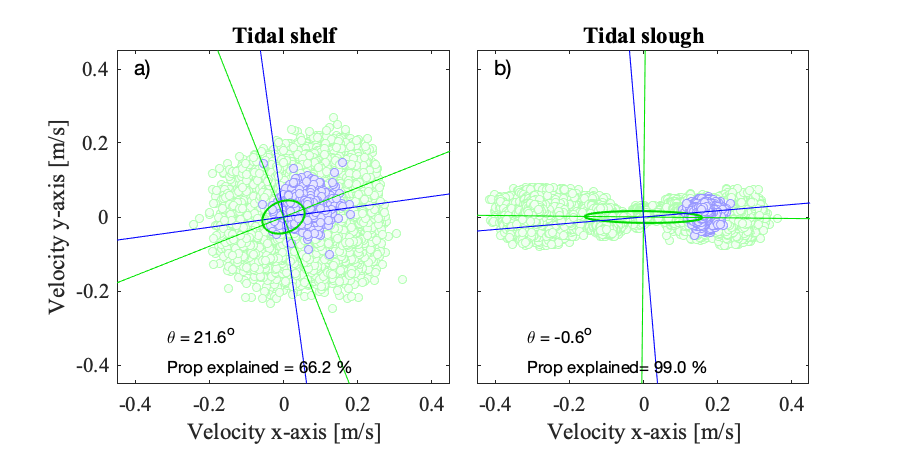Rotation of the velocity measurements: Difference between revisions
No edit summary |
No edit summary |
||
| Line 7: | Line 7: | ||
The velocities are measured in either the instrument's coordinate system (XYZ), beam coordinates or more rarely in the earth's coordinate system (east, north and up). Ideally, the instrument's x-axis is aligned with the general direction of the mean flow. {{FontColor|fg=red|text=Elaborate more why, for bbl flows when the vertical is hindered or when shear stress qty are desired (correlated noise is projected during rotations for some acoustic instruments).}} | The velocities are measured in either the instrument's coordinate system (XYZ), beam coordinates or more rarely in the earth's coordinate system (east, north and up). Ideally, the instrument's x-axis is aligned with the general direction of the mean flow. {{FontColor|fg=red|text=Elaborate more why, for bbl flows when the vertical is hindered or when shear stress qty are desired (correlated noise is projected during rotations for some acoustic instruments).}} | ||
[[File:Frame of reference adv.png|600px|frame|Examples of measured velocities from two ADVs highlighting that their x-axis may be un-aligned with the flow's. The blue dots and lines that represent the principal axes are for a 5-min subset of the entire timeseries shown in red. The left example (a) is from the shelf break in ~190 m of water, while the right example (b) is from a tidally-influenced slough (a few meters deep). The statistics in each panel were estimated for the entire timeseries, and highlights that the flow's frame of reference is much more variable in the Tidal shelf example (a) than the Tidal Slough (b). Another key difference is that in the slough example (b), the instrument's x-axis was oriented along the length of the channel, and thus in the general direction of the flow. This is the ideal set-up for turbulence measurements from acoustic-Doppler velocity-meters.]] | |||
[[File:Frame of reference adv.png|600px| | |||
Revision as of 14:59, 8 March 2022
{{#default_form:Processing}}
{{#arraymap:
Velocity point-measurements
|,|x||}}
{{#arraymap:level 2 segmented and quality controlled|,|x||}}
Measured velocities must be rotated in the flow's frame of reference since inertial subrange model differs between the velocity components, and the effects of anisotropy are more pronounced in the transverse and vertical direction.
The velocities are measured in either the instrument's coordinate system (XYZ), beam coordinates or more rarely in the earth's coordinate system (east, north and up). Ideally, the instrument's x-axis is aligned with the general direction of the mean flow. Elaborate more why, for bbl flows when the vertical is hindered or when shear stress qty are desired (correlated noise is projected during rotations for some acoustic instruments).

